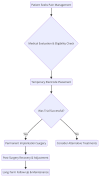Closed-Loop Spinal Cord Stimulation in Chronic Pain Management: Mechanisms, Clinical Evidence, and Emerging Perspectives
- PMID: 40426918
- PMCID: PMC12108722
- DOI: 10.3390/biomedicines13051091
Closed-Loop Spinal Cord Stimulation in Chronic Pain Management: Mechanisms, Clinical Evidence, and Emerging Perspectives
Abstract
Background: Chronic pain remains a major clinical challenge, which is often resistant to conventional treatments. Spinal cord stimulation has been used for decades to manage refractory pain, traditionally relying on open-loop systems with fixed-output stimulation. However, these systems fail to account for physiological variability, leading to inconsistent pain relief. Closed-loop spinal cord stimulation represents a significant advancement by utilizing evoked compound action potentials to continuously modulate stimulation intensity in real-time, ensuring more stable and effective pain management. Methods: A comprehensive literature review was conducted using PubMed and ClinicalTrials.gov to identify and synthesize relevant published and ongoing studies with a focus on open-loop spinal cord stimulation for managing lower back pain. Results: Clinical trials, including the Avalon and Evoke studies, have demonstrated that closed-loop spinal cord stimulation provides superior pain relief, functional improvement, and reduced opioid dependence compared to traditional open-loop systems. Patients receiving closed-loop stimulation reported significantly higher rates of sustained pain reduction, improved quality of life, and fewer complications related to overstimulation. Emerging studies suggest its potential for conditions beyond back pain, such as neuropathic pain, cancer-related pain, and Raynaud's phenomenon. Furthermore, cost-effectiveness analyses indicate that closed-loop spinal cord stimulation is a more economically viable treatment option compared to conventional medical management and open-loop systems. Conclusions: Closed-loop spinal cord stimulation represents a transformative development in neuromodulation, offering personalized and adaptive pain management that is distinct from open-loop spinal cord stimulation. Further research is warranted to explore its long-term durability, broader applications, and integration with emerging technologies in pain management.
Keywords: avalon; chronic pain; closed-loop spinal cord stimulation; cost-effectiveness; evoke; evoked compound action potentials; lower back pain; neuromodulation; pain management; spinal cord stimulation.
Conflict of interest statement
The authors declare no conflicts of interest.
Figures
Similar articles
-
Long-term safety and efficacy of closed-loop spinal cord stimulation to treat chronic back and leg pain (Evoke): a double-blind, randomised, controlled trial.Lancet Neurol. 2020 Feb;19(2):123-134. doi: 10.1016/S1474-4422(19)30414-4. Epub 2019 Dec 20. Lancet Neurol. 2020. PMID: 31870766 Clinical Trial.
-
Durability of Clinical and Quality-of-Life Outcomes of Closed-Loop Spinal Cord Stimulation for Chronic Back and Leg Pain: A Secondary Analysis of the Evoke Randomized Clinical Trial.JAMA Neurol. 2022 Mar 1;79(3):251-260. doi: 10.1001/jamaneurol.2021.4998. JAMA Neurol. 2022. PMID: 34998276 Free PMC article. Clinical Trial.
-
Multicenter, Randomized, Double-Blind Study Protocol Using Human Spinal Cord Recording Comparing Safety, Efficacy, and Neurophysiological Responses Between Patients Being Treated With Evoked Compound Action Potential-Controlled Closed-Loop Spinal Cord Stimulation or Open-Loop Spinal Cord Stimulation (the Evoke Study).Neuromodulation. 2019 Apr;22(3):317-326. doi: 10.1111/ner.12932. Epub 2019 Mar 3. Neuromodulation. 2019. PMID: 30828946 Clinical Trial.
-
The Application of Artificial Intelligence to Enhance Spinal Cord Stimulation Efficacy for Chronic Pain Management: Current Evidence and Future Directions.Curr Pain Headache Rep. 2025 May 20;29(1):85. doi: 10.1007/s11916-025-01400-4. Curr Pain Headache Rep. 2025. PMID: 40394275 Review.
-
The American Society of Pain and Neuroscience (ASPN) Guidelines and Consensus on the Definition, Current Evidence, Clinical Use and Future Applications for Physiologic Closed-Loop Controlled Neuromodulation in Chronic Pain: A NEURON Group Project.J Pain Res. 2025 Feb 3;18:531-551. doi: 10.2147/JPR.S475527. eCollection 2025. J Pain Res. 2025. PMID: 39926188 Free PMC article. Review.
Cited by
-
Automated Neural Dosing for Fast-Acting Subperception Therapy: Sustained Spinal Cord Stimulation Outcomes from a Multicenter Study.Pain Ther. 2025 Aug;14(4):1417-1429. doi: 10.1007/s40122-025-00758-y. Epub 2025 Jul 3. Pain Ther. 2025. PMID: 40603812 Free PMC article.
References
-
- Campbell T.S., Johnson J.A., Zernicke K.A. Gate Control Theory of Pain. In: Gellman M.D., editor. Encyclopedia of Behavioral Medicine. Springer International Publishing; Cham, Switzerland: 2020. pp. 914–916. - DOI
-
- Khelemsky Y., Malhotra A., Gritsenko K. Academic Pain Medicine A Practical Guide to Rotations, Fellowship, and Beyond: A Practical Guide to Rotations, Fellowship, and Beyond. Anesth. Analg. 2019;131:e1. doi: 10.1007/978-3-030-18005-8. - DOI
-
- Brooker C., Russo M., Cousins M.J., Taylor N., Holford L., Martin R., Boesel T., Sullivan R., Hanson E., Gmel G.E., et al. ECAP-Controlled Closed-Loop Spinal Cord Stimulation Efficacy and Opioid Reduction over 24-Months: Final Results of the Prospective, Multicenter, Open-Label Avalon Study. Pain. Pract. 2021;21:680–691. doi: 10.1111/papr.13008. - DOI - PMC - PubMed
-
- Global, regional, and national incidence, prevalence, and years lived with disability for 354 diseases and injuries for 195 countries and territories, 1990-2017: A systematic analysis for the Global Burden of Disease Study 2017. Lancet. 2018;392:1789–1858. doi: 10.1016/S0140-6736(18)32279-7. - DOI - PMC - PubMed
Publication types
LinkOut - more resources
Full Text Sources


